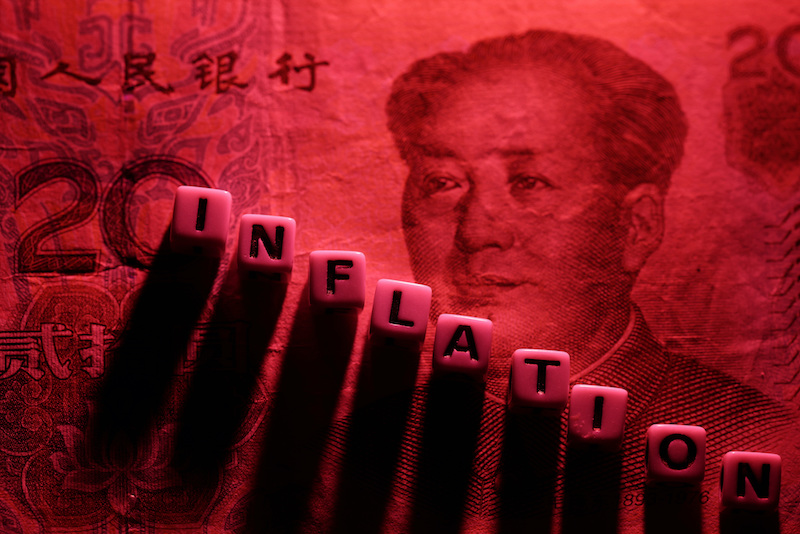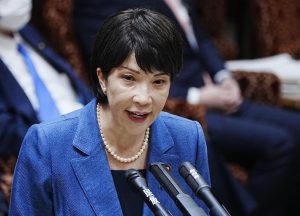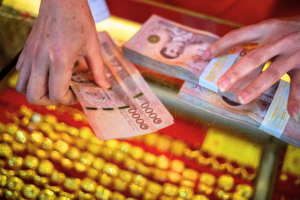Officials from China’s central bank said on Wednesday that stabilising the foreign exchange market is its top priority, after the yuan weakened to its lowest level since the global financial crisis in 2008.
Comments from the People’s Bank of China came after the yuan tumbled further against the rising dollar in foreign exchange trading, taking its losses to more than 12% this year.
The onshore yuan finished at 7.2458 per dollar, its weakest close since January 2008 – down 658 pips or 0.91% from Tuesday night’s late close of 7.18.
The offshore yuan, pressured by the likelihood of more rate hikes by the US Federal Reserve, suffered even worse, weakening 1.15% on the day to trade at 7.2635 around 0830 GMT.
This was its lowest level since data became available in 2011.
The PBOC said the FX market was largely operating in an orderly manner, but warned against making heavy one-way bets on the currency. It reiterated that the yuan has a solid basis to be basically stable.
“The foreign exchange market is of great importance, and maintaining stability is the top priority,” the PBOC stressed.
Market participants usually view such remarks as a sign that authorities are growing uncomfortable with rapid currency movements.
The PBOC also urged members of the China FX Market Self-Regulatory Framework, which serves as a self-regulatory and coordinating mechanism, to prevent sharp fluctuations in the currency.
It added that relevant departments should strengthen expectation management to prevent speculative trading.
“One must realize, that exchange rates can never be predicted precisely, and two-way fluctuation is the norm,” the PBOC said.
“Do not make one-way bet on currency appreciation or depreciation. You will definitely lose if you keep gambling.”
ALSO SEE: China to Lift FX Reserve Ratio, to Slow Yuan Plunge
Greenback Strength
Currency traders said the yuan was reacting to broad greenback strength in global markets as the dollar hit a fresh two-decade peak against a basket of currencies, buoyed by safe-haven demand and a hawkish Federal Reserve.
Several currency traders said corporate dollar buying was very strong on Wednesday, piling additional pressure on the yuan.
“Those who want to convert their FX receipts into yuan are holding back and waiting for better prices,” a trader at a foreign bank said.
A second trader at a foreign bank said the weakness in the yuan was in line with other currencies on Wednesday.
“Non-dollar currencies all crashed in early trades, the yuan can’t escape,” a trader at a foreign bank said.
Prior to market opening, the People’s Bank of China (PBOC) set the midpoint rate at 7.1107 per dollar, the lowest level in over two years, and 385 pips or 0.54% weaker than the previous fix of 7.0722.
PBOC Keen to Slow Currency’s Depreciation
The daily midpoint fixing limits onshore trade to a narrow range of 2% on either side, and Wednesday’s guidance kept the range to between 6.9685 and 7.2529. The domestic closing price was 71 pips from the weaker end of the downside limit.
“The authorities have been seeking to slow the pace of depreciation through setting much stronger than expected fixings, but it is clear that there is no particular level that they are seeking to defend,” analysts at ANZ said in a note.
“Hence, in the face of further dollar strength, the authorities will ultimately allow the yuan to weaken further but will act to ensure any move is not disorderly.”
The declines come even as China’s central bank on Monday announced fresh steps to slow the pace of the yuan’s recent fall by making it more expensive to bet against the currency.
Earlier this month, the PBOC also cut the amount of foreign exchange reserves that financial institutions must hold in a move also seen as aimed at slowing the yuan’s depreciation.
Efforts by authorities to stem yuan weakness was having a limited impact, a second trader at a Chinese bank said.
Unlike most other central banks which are rapidly tightening policy to tackle soaring inflation, the PBOC has been easing its settings to support the sputtering Chinese economy.
A source said late on Tuesday that Chinese monetary authorities are asking local banks to revive a yuan fixing tool it abandoned two years ago as they seek to steer and defend the rapidly weakening currency.
“We believe the CNY fixing guidance will remain the primary tool to support the RMB and, if necessary, the PBOC will freeze the CNY fixing to lock the USD/CNY spot at the 2% upper trading limit,” Ken Cheung, chief Asian FX strategist at Mizuho Bank, said.
“This will prove to be the least costly but effective policy to cap the USD/CNY spot,” Cheung said.
He expects the authorities could take more action including verbal messages, often known as “window guidance”, to slow the pace of yuan depreciation.
The dollar’s strength comes as the US central bank hiked interest rates by three-quarters of a percentage point for a third straight time last week and signalled that borrowing costs would keep rising this year.
- Reuters with additional editing by Jim Pollard
NOTE: This report was updated twice on September 28, 2022 with details after the close of Wednesday’s trading session, and then comments by the PBOC.
ALSO SEE:
Asian Currencies Sink as Dollar Soars, Banks Hike Rates
US Banks Pressured to Take Tougher Stance on Taiwan, China























